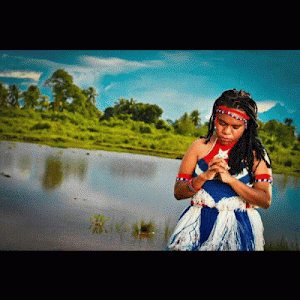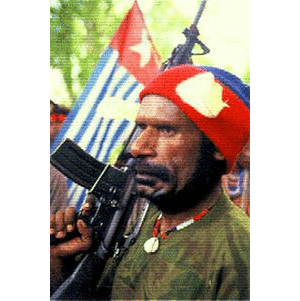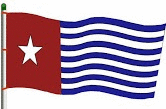 |
| Image Credit: Korowai woman, West Papua © Survival International |
The people of West Papua have been calling for
self-determination for half a century – a struggle for liberation from an
Indonesian military occupation that has seen as many as 500,000 Papuans
killed. A recent development in this long campaign is the suspicious death of a
commander of the rebel Free Papua Movement (OPM), Danny Kogoya, on December 15.
The cause of death, as described in the medical report, was liver failure,
bought on by the presence of “unusual chemicals in his body,” raising concern
that he was poisoned.
At the time of his death, Kogoya was at Vanimo hospital, in
Papua New Guinea (PNG), receiving treatment for his leg. His leg was amputated
in 2012 – without his consent – at a police hospital in Jayapura, West Papua,
after Indonesian security forces shot him during an arrest. According to the Asian Human Rights Commission(AHRC), a doctor at Vanimo
hospital alleged that the chemicals were administered while Kogoya was at the
police hospital in Jayapura and that he had been slowly poisoned to death by
the Indonesian state authorities.
When Kogoya’s family submitted a request, with the medical
report attached, to Vanimo Court House, asking for his body to be buried in
West Papua, the Court decided to treat the death as a murder and called for an
autopsy. AHRC reports that when the autopsy was scheduled, four individuals –
two of them identified as Indonesian consulate staff – met with hospital
management and prevented the autopsy from taking place.
A series of subsequent negotiations between family members,
Indonesian consulate officials and PNG local authorities resulted in the
autopsy being agreed to. But latest reports indicate
the autopsy is yet to happen.
Whether foul play is proven in the death of Kogoya or not, the
incident is another in a long line in the liberation movement in West Papua,
which has seen civilians with suspected links to separatists tortured,
political activists murdered and perpetrators act with impunity.
Geographically, West Papua sits beside PNG, forming the western
half of the resource-rich island of New Guinea, about 300 km from the northern
tip of Australia. The West Papua region is split into two provinces: West Papua
and Papua. Its indigenous people have Melanesian roots, making them culturally
and ethnically similar to their counterparts in PNG, but the formers’ turbulent
colonial history and ongoing struggle for self-determination sets them starkly
apart from their neighbors.
After WWII, the Dutch, who colonized West Papua, began making
preparations for its liberation, while Indonesia continued to lay claim to the
territory. In 1961, Papuans raised their flag – The Morning Star – sang their
national anthem and declared their independence. Soon after, Indonesia invaded,
supported and armed by the Soviet Union. Fearing the spread of communism and
with mining interests in West Papua, the U.S. intervened, and along with the
UN, brokered the New York Agreement, giving interim control of West Papua
(under UN supervision) to Indonesia in 1963, until a referendum could take
place granting West Papuans a vote for either integration into Indonesia or
self-determination.
Over the next several years, before the vote, it’s estimated that
30,000 West Papuans were killed by Indonesian military, in a brutal silencing
of dissent and suppression of liberationist ideals. In 1969, the vote –
ironically called “The Act Of Free Choice” was fraudulent, the outcome
controlled. Just one percent of
the population was selected to vote, and those chosen were intimidated by
security forces, resulting in a unanimous vote for West Papua to be ruled by
Indonesia. A man claiming to be part of the one percent who voted describes the
scenario in a documentary,
his face obscured, saying that a gun was held to his head, as he was given the
ultimatum – vote for Indonesia or be killed.
Since then, mass atrocities have been carried out by Indonesian
security forces and human rights abuses continue to this day. West Papua is the
most heavily militarized region of Indonesia, with an estimated 45,000 troops presently
deployed, and an extra 650 soldiers to
patrol near the PNG border from February.
Paul Barber, coordinator of TAPOL, which works to
promote human rights, peace and democracy in Indonesia, told The Diplomat that members of the military have
committed horrific human rights violations in West Papua over the last fifty
years, and have enjoyed complete impunity. A recent example occurred in June
2012, when security forces stationed in Wamena (in the Central Highlands), ran
amok, bayoneting civilians and burning houses and vehicles.
‘’Violations often occur in remote areas, including the border
area, and many go unreported. Troops tend to be unwelcome and underpaid, and
their arrival usually precedes military business rackets, illegal logging, and
human rights violations, including sexual violence against women and girls.’’
Barber said that political activists and human rights defenders
are frequently branded as separatists and traitors and that the Indonesian
Government continues to “isolate, silence and stigmatize its critics” as a
means of denying the political nature of the problem.
The Security Approach: Silencing Voices of Dissent
The liberation movement comprises both violent and non-violent
groups.
Militant group OPM, (which Kogoya was involved in), leads a
low-level insurgency, and have attacked military, police and occasionally
civilian targets over the years. A 2002 Amnesty International report found
that counterinsurgency operations by Indonesian security forces have resulted
in: “gross human rights violations, including extrajudicial executions,
enforced disappearances, torture and arbitrary detentions.”
Given the omnipresent suspicion that all West Papuans are
separatists, or support separatist movements, the response of Indonesian troops
has often been the same whether groups use peaceful tools, like demonstrations,
or guerilla tactics. In other words, West Papuans need not be armed fighters to
be persecuted, arrested, tortured or executed.
The shocking prevalence of
torture by Indonesian security forces was revealed by a recent study, which
found on average, one incident of torture has taken place every six weeks for
the past half century. Of the 431 documented cases reviewed, just 0.05 percent
of those tortured were proven to be members of militias – the vast majority of
victims were civilians, most commonly farmers and students.
Resources: http://thediplomat.com















0 komentar:
Posting Komentar